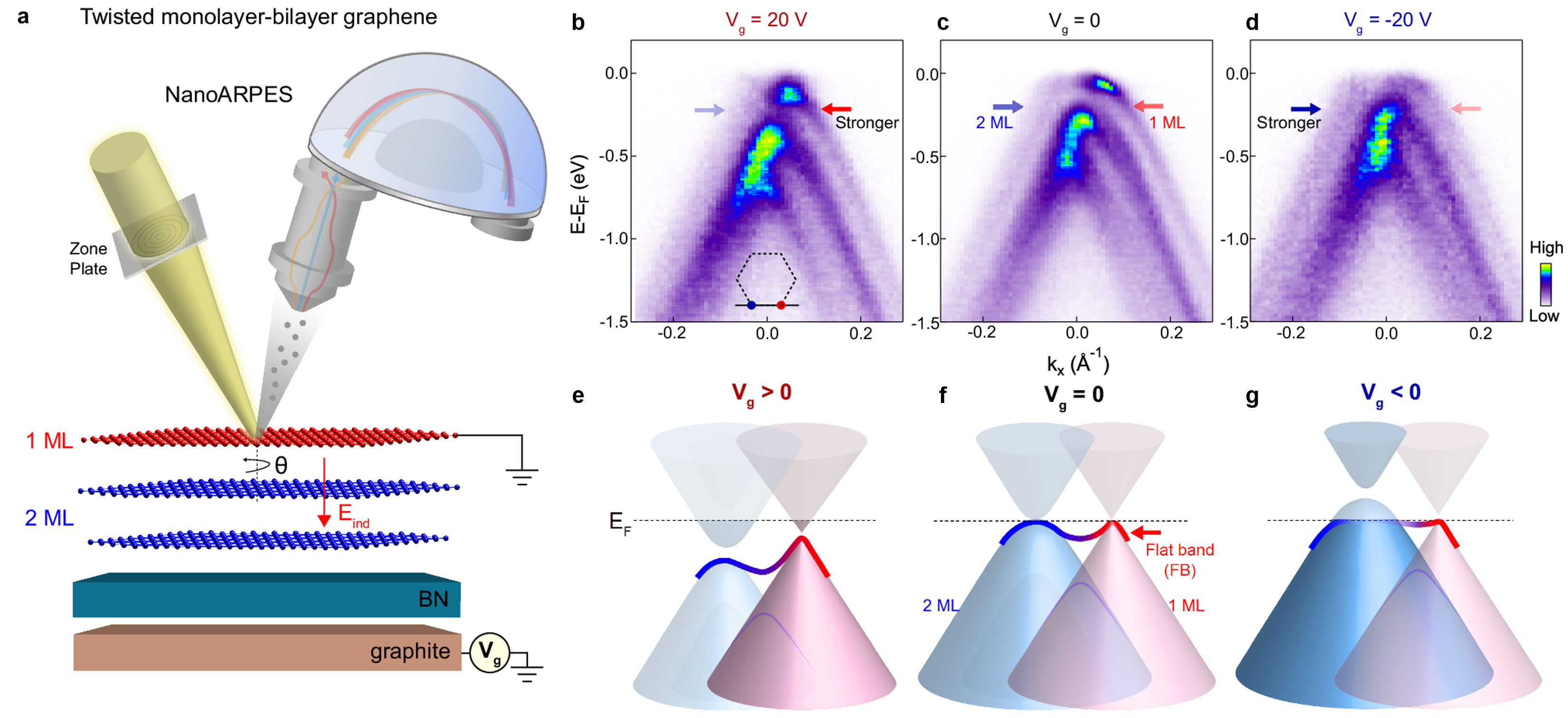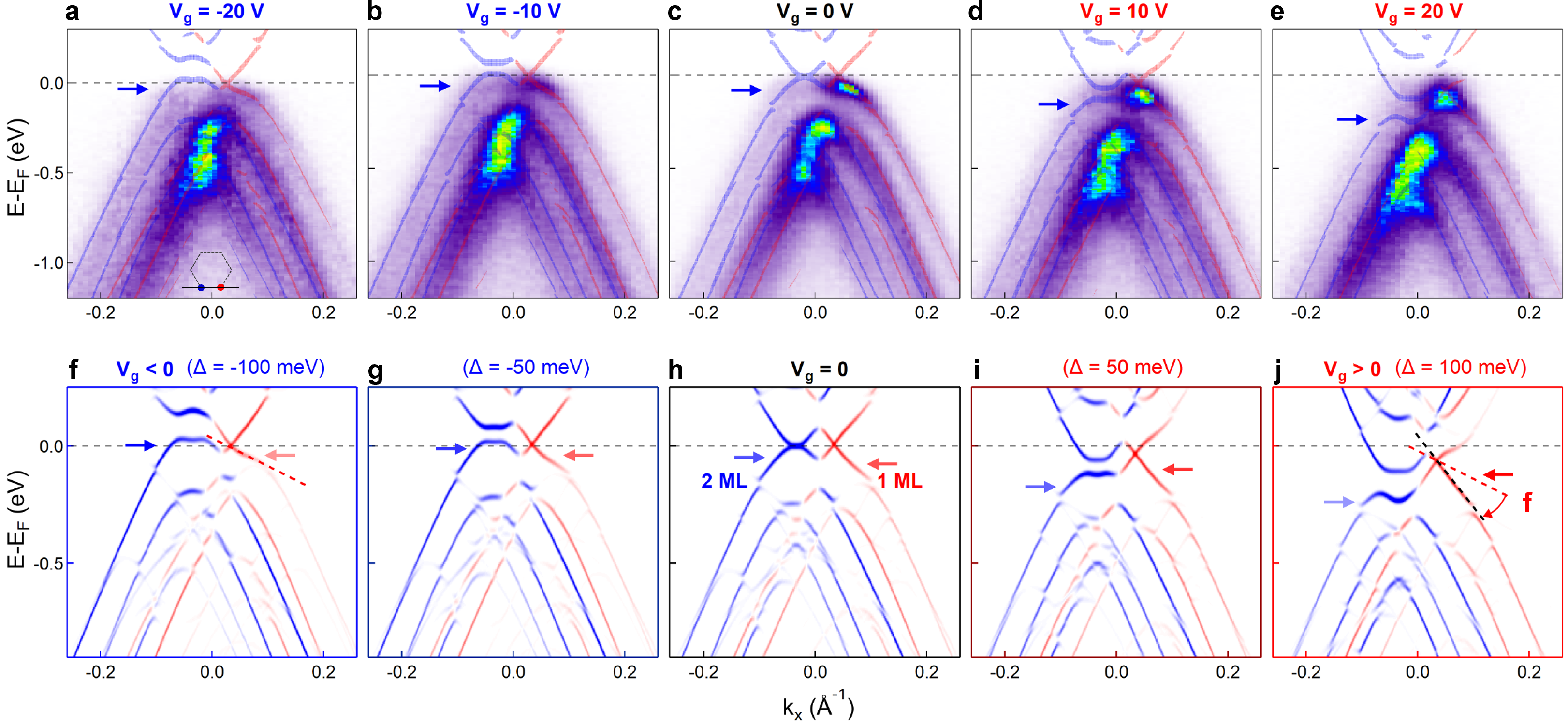Twisted bilayer graphene has attracted much attention because it exhibits a series of novel correlated phenomena near the magic angle, such as unconventional superconductivity, Mott insulation, magnetism, etc. Its center physics is derived from the flat band electronic structure near Fermi energy, so the detection and engineering of the flat band electronic structure is the key to understand the related physics of the twisted system. Following the recent report in Nature Materials on the evolution of the flat band electronic structure of twisted bilayer graphene with twist angle, Shuyun Zhou's group recently extended the flat band study to twisted monolayer-bilayer graphene, and by applying in situ. gate voltage control method, they further achieve the field-tunable electronic structure in twisted monolayer-bilayer graphene. It is the first time to reveal the dichotomic field-tunable electronic structure in the twisted monolayer-bilayer graphene, that is, by changing the direction of the electric field, the flat band electronic structure more reflects the characteristics of monolayer and bilayer graphene.The research work is entitled "Observation of dichotomic field-tunable electronic structure in twisted monolayer-bilayer graphene," published in Nature Communications.

Fig. 1 Dichotomic field-tunable electronic structure in twisted single-double graphene. (a) Schematic diagram of NanoARPES measurements where the gate voltage can be adjusted in situ. (b-d) Twisted monolayer-bilayer graphene (2.2°) NanoARPES measured electronic structure at gate voltages of 20 V, 0 V, and -20 V. (e-g) Schematic summary of dichotomic evolution of the electronic structure of twisted monolayer-bilayer graphene under external field.
Among the twisted graphene system, the twisted monolayer-bilayer graphene exhibits unique properties by breaking the inversion symmetry perpendicular to the interface direction. For example, by applying an electric field perpendicular to the out-of-plane direction to the twisted monolayer-bilayer graphene, the researchers observed asymmetric evolution of the correlated state phase diagram with the electric field using transport measurements. In this system, the evolution of the flat band electronic structure under the external electric field is the fundamental physics, so it is of great significance to detect the evolution of the flat band electronic structure under the condition of applying the in-situ electric field.
By improving the sample preparation method of the twisted graphene system, Shuyun Zhou's research team successfully obtained high-quality twisted monolayer-bilayer graphene samples that can apply in situ. gate voltage, and combined with two complementary experimental techniques, nano-spot angle-resolved photoemission spectroscopy (NanoARPES) with hundred-nanometer spatial resolution (Fig. 1) and atomic force microscopy (AFM). The clear flat band electronic structure at the Fermi energy is directly revealed, and its bandwidth is found to be comparable to the Coulomb interaction, which confirms the existence of strong electron-electron interaction in the system. More interestingly, two significant electric field evolution effects were observed in the electronic structure of the twisted monolayer-bilayer under in-situ. gate voltage: 1. spectral weight (ARPES signal intensity) recontribution among the monolayer and bilayer graphene (Fig. 1); 2. the flat band becomes flatter or has stronger dispersion under negative or positive voltage (Fig. 2), reflecting the properties of bilayer or monolayer graphene. By combining experimental measurements with theoretical calculations, Shuyun Zhou’s group and collaborators revealed the asymmetric evolution of the spectral weight and flat band dispersion in twisted monolayer-bilayer due to the redistribution of charge between layers under applied electric fields. These results provide important information for understanding the general law of evolution of electron structure with external field in twisted system.

Fig. 2 Evolution of flat band electronic structure of twisted monolayer-bilayer graphene under electric field. (a-e) NanoARPES measured evolution of electronic structures under different electric fields. The measurement direction cutting through both monolayer and bilayer graphene K points, as shown in the inset in (a). (f-j) Calculated evolution of electronic structure under different electric fields, which is consistent with the experimental observation in (a-e).
Professor Shuyun Zhou from the Department of Physics of Tsinghua University is the corresponding author of the paper, and Dr. Hongyun Zhang and Ph.D. student Qian Li from the Department of Physics of Tsinghua University are the co-first authors of the paper. The main cooperation team includes Professor Hongming Weng and Quansheng Wu from the Institute of Physics of the Chinese Academy of Sciences, Professor Jeil Jung from the University of Seoul, Professor Wenhui Duan and Professor Pu Yu from the department of Physics at Tsinghua University, and the ANTARES NanoARPES beamline at Synchrotron SOLEIL in France. This work is supported by the National Key R&D Program of China, the National Natural Science Foundation of China, the Basic Science Center Project, the Shuimu Tsinghua Scholar program and the China Postdoctoral Science Foundation, and the State Key Laboratory of Low-Dimensional Quantum Physics of Tsinghua University.
Full-text link:https://www.nature.com/articles/s41467-024-48166-8
Editor: Li Han

